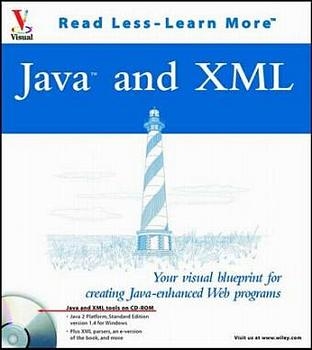
Java and XML
Hungry Minds Inc,U.S.
978-0-7645-3683-0 (ISBN)
- Titel ist leider vergriffen;
keine Neuauflage - Artikel merken
Learn the concepts, syntax and APIs (Application Program Interface) of Java. It includes information about DTDs, datatypes, child data, Cascading Style Sheets, XSL, data islands, ActiveX, metadata, JavaScript, Xlink, Xpointer, and more! About the CD-ROM: The CD will include coding examples. It includes fully searchable e-version of the book.
Ernest Friedman--Hill, Ph.D. is a Principal Member of Technical Staff in the Distributed Computing Research department at Sandia National Laboratories. He received his doctorate from MIT in 1992. At Sandia, Dr. Friedman--Hill's research topics have included the use of Intelligent Agents in scientific computing and in manufacturing. He has taught Java programming to over 3000 students since he first began in 1996. He is the author of Java: Your visual blueprint. Emily Vander Veer specializes in translating Web--based technologies into straightforward, easy--to--understand concepts and practical examples for consumer, business, and technical audiences. In the past few years Emily has written several ...For Dummies books (including JavaScript For Dummies, JavaBeans For Dummies, and Netscape Visual JavaScript For Dummies). She is the author of XML: Your visual blueprint.
1) INTRODUCING JAVA AND XML. Introducing the Java Phenomenon. Introducing XML. Java and XML Combined. 2) JAVA BASICS. Install the Java SDK. Object--Oriented Programming Concepts. The Java Class Library. Java Conventions. Create a Source File. Create a Method. Create the Method Body. Compile a Java Program. Execute a Java Program. 3) JAVA PROGRAMMING. Create an Object. Work with Object Fields. Specify the Data Type for a Variable. Work with Strings. Call a Method. Using Return Values and Arguments. Using the if Statement. Using the for Statement. Using The While Or Do While Loop. Using the Switch Statement. Create an Array. Create a Package. Import a Package. Extend a Class. Create an Exception. Handle Errors. Understanding Variable Scope. 4) XML BASICS. Create an XML Document. Verify Well--Formedness. Create Elements. Add Attributes. Add a Comment. Include Special Processing Instructions. Using Predefined XML Entities. Include Nonstandard Text. 5) XML DOCUMENT TYPE DEFINITIONS. Declare a DTD. Create an External DTD File. Declare a Container Element. Define the Structure of Elements. Define Element Attributes. Declare Attributes as Words. Restrict Attributes to a List of Values. Create Internal General Entities. Create a Notation. Create External General Entities. Using Namespaces. Using the XML Namespace Attribute. 6) XML SCHEMAS. Introducing XML Schemas. Create an XML Schema Declaration. Declare an Element. Assign an XML Schema to an XML Document. Validate an XML Document. Declare a Container Element. Declare Optional Elements. Specify Data Types. Constrain Element Values. Constrain Element Values to a List. Declare an Attribute. Constrain the Values of an Attribute. Reference Predefined Elements. Create a Group of Attributes. Constrain Values Using Regular Expressions. 7) THE SAX API. An Introduction to the SAX API. Install the Xerces XML Parser. Set the CLASSPATH Environment Variable. Create an Event Handler Class. Parse an XML Document. Detect Elements in an XML Document. Extract Textual Element Content. Determine the Number of Element Attributes. Determine the Name of Attributes. Determine the Value of Attributes. Determine the Line Number Being Parsed. Determine Ignorable Whitespace in an Element. Work with Processing Instructions. Parse Multiple XML Documents Using Multiple Event Handlers. Create an Error Handler. Create a Custom Error Message. Create an Entity Resolver. Using the Default Handler. Determine Feature and Property Settings. Detect Notation Declarations. Create a Declaration Handler. Create a Lexical Handler. Turn on Validation. Toggle Namespace and Prefix Usage. 8) THE DOM. Introducing the DOM. Retrieve the Root Element Name. Determine Node Type. Work with Nodes. Transverse All Element Nodes. Determine Names of Attributes. Determine the Values of Attributes. Work with Processing Instructions. Detect Entity References. Detect General Entities in the DTD. Retrieve DTD Information. Retrieve Text Information. Extract Comments. Extract CDATA Sections. Retrieve Notation Declarations. Navigate Nodes. Create an XML Document. Create a New DOM Tree with a Root Element. Add Attributes to an Element. Add a Child Element. Create a Text Node. Create Other Node Types. Copy Nodes. 9) JDOM. Introducing JDOM. Create the Root Element. Add Content to the Root Element. Create Child Elements. Read an XML Document. Extract Element Text Content. Insert a Comment. Insert a CDATA Section. Add Processing Instructions. Add Attributes to an Element. Work with Attribute Objects. Save an XML Document. Work with Child Elements. Insert Pre--defined Entity References. Determine Element Type. Output a DOM Tree Using JDOM. 10) JAXP. Introducing JAXP. Parse an XML Document. Detect Events. Configure Factory Settings. Set SAXParser Features. Parse a Document Using DOM. Create an Error Handler for Use with DOM. APPENDIX A. SAX API Quick Reference. DOM API Quick Reference. JDOM Quick Reference. JAXP Quick Reference. APPENDIX B. Java Quick Reference. APPENDIX C. XML Quick Reference. APPENDIX D. What's on the CD--ROM. Using the E--Version of this Book. Wiley Publishing, Inc. End--User License Agreement. INDEX. CD--ROM INSTALLATION INSTRUCTIONS.
| Erscheint lt. Verlag | 24.7.2002 |
|---|---|
| Reihe/Serie | Read less - learn more |
| Zusatzinfo | illustrations |
| Verlagsort | Foster City |
| Sprache | englisch |
| Maße | 205 x 225 mm |
| Gewicht | 709 g |
| Einbandart | Paperback |
| Themenwelt | Informatik ► Programmiersprachen / -werkzeuge ► Java |
| Mathematik / Informatik ► Informatik ► Web / Internet | |
| ISBN-10 | 0-7645-3683-4 / 0764536834 |
| ISBN-13 | 978-0-7645-3683-0 / 9780764536830 |
| Zustand | Neuware |
| Haben Sie eine Frage zum Produkt? |
aus dem Bereich


